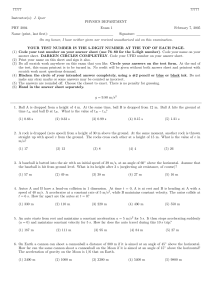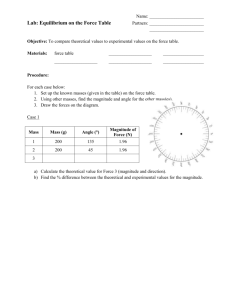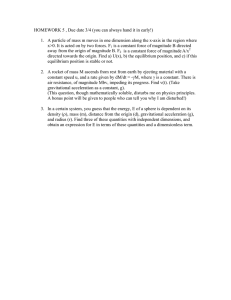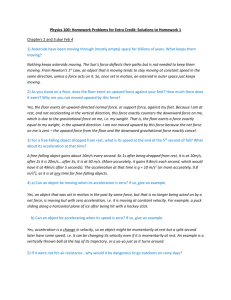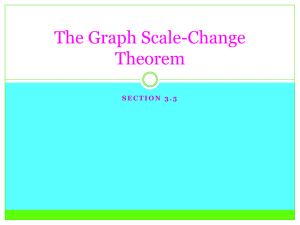77777 Mueller/Saab PHYSICS DEPARTMENT PHY 2048
advertisement
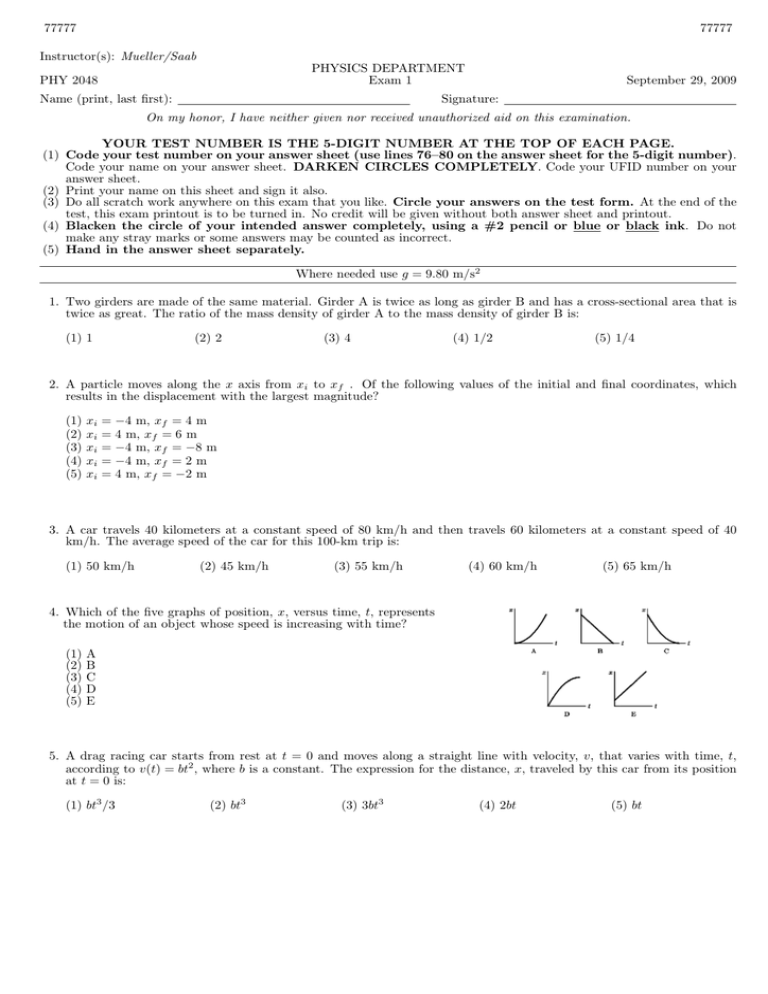
77777 77777 Instructor(s): Mueller/Saab PHYSICS DEPARTMENT Exam 1 PHY 2048 Name (print, last first): September 29, 2009 Signature: On my honor, I have neither given nor received unauthorized aid on this examination. YOUR TEST NUMBER IS THE 5-DIGIT NUMBER AT THE TOP OF EACH PAGE. (1) Code your test number on your answer sheet (use lines 76–80 on the answer sheet for the 5-digit number). Code your name on your answer sheet. DARKEN CIRCLES COMPLETELY. Code your UFID number on your answer sheet. (2) Print your name on this sheet and sign it also. (3) Do all scratch work anywhere on this exam that you like. Circle your answers on the test form. At the end of the test, this exam printout is to be turned in. No credit will be given without both answer sheet and printout. (4) Blacken the circle of your intended answer completely, using a #2 pencil or blue or black ink. Do not make any stray marks or some answers may be counted as incorrect. (5) Hand in the answer sheet separately. Where needed use g = 9.80 m/s2 1. Two girders are made of the same material. Girder A is twice as long as girder B and has a cross-sectional area that is twice as great. The ratio of the mass density of girder A to the mass density of girder B is: (1) 1 (2) 2 (3) 4 (4) 1/2 (5) 1/4 2. A particle moves along the x axis from xi to xf . Of the following values of the initial and final coordinates, which results in the displacement with the largest magnitude? (1) (2) (3) (4) (5) xi xi xi xi xi = −4 m, xf = 4 m = 4 m, xf = 6 m = −4 m, xf = −8 m = −4 m, xf = 2 m = 4 m, xf = −2 m 3. A car travels 40 kilometers at a constant speed of 80 km/h and then travels 60 kilometers at a constant speed of 40 km/h. The average speed of the car for this 100-km trip is: (1) 50 km/h (2) 45 km/h (3) 55 km/h (4) 60 km/h (5) 65 km/h 4. Which of the five graphs of position, x, versus time, t, represents the motion of an object whose speed is increasing with time? (1) (2) (3) (4) (5) A B C D E 5. A drag racing car starts from rest at t = 0 and moves along a straight line with velocity, v, that varies with time, t, according to v(t) = bt2 , where b is a constant. The expression for the distance, x, traveled by this car from its position at t = 0 is: (1) bt3 /3 (2) bt3 (3) 3bt3 (4) 2bt (5) bt 77777 77777 ~ − B| ~ = |A| ~ + |B| ~ and neither A ~ nor B ~ vanish, then: 6. If |A (1) (2) (3) (4) (5) ~ and B ~ are parallel and in opposite directions A ~ and B ~ are parallel and in the same direction A ~ and B ~ is 45◦ the angle between A ~ ~ is 60◦ the angle between A and B ~ is perpendicular to B ~ A ~+B ~ = 2C, ~ A ~−B ~ = C, ~ and C ~ = 2î − 2ĵ, then what is the value of the dot product A ~ · B? ~ 7. If A (1) 6 (2) zero (3) 4 (4) 3 (5) 2 8. Two vectors lie with their tails at the same point. When the angle between them is increased by 20◦ the magnitude of their vector product remains unchanged. What was the original angle between them? (1) 80◦ (2) 30◦ (3) 45◦ (4) 90◦ (5) 60◦ 9. Starting at time t = 0, an object moves along a straight line. Its coordinate in meters is given by x(t) = 48t − t3 , where t is in seconds. What is the acceleration of the object when it momentarily stops (with t > 0)? (1) −24 m/s2 (2) 24 m/s2 (3) −12 m/s2 (4) 12 m/s2 (5) zero 10. An object is thrown vertically upward near the surface of the Earth. Which of the five graphs represents the velocity, v, of the object as a function of the time t? The positive direction is taken to be upward. (1) (2) (3) (4) (5) C B A D E 11. An object is released from rest at t = 0 near the surface of the Earth. How far does it fall during the first second of its fall (i.e., from t = 0 s to t = 1 s)? (1) 4.9 m (2) 9.8 m (3) 14.7 m (4) 19.6 m (5) 24.5 m 12. A motorist drives along a straight road at a constant speed of 80 m/s. Just as she passes a parked motorcycle police officer, the officer takes off after her at a constant acceleration. If the officer maintains this constant value of acceleration, what is the speed of the police officer when he reaches the motorist? (1) 160 m/s (2) 80 m/s (3) 180 m/s (4) 100 m/s (5) need to know the officer’s acceleration 13. A Ferris wheel, near the surface of the Earth, with a radius of 8 m rotates at a constant speed and makes 1 revolution every 10 s. When a passenger is at the top, essentially a diameter above the ground, he releases a ball. How far horizontally from the point on the ground directly under the release point does the ball land? (1) 9.1 m (2) 12.3 m (3) 2.9 m (4) 6.4 m (5) 28.6 m 77777 77777 14. Near the surface of the earth, a startled armadillo leaps vertically upward at time t = 0. At time t = 0.5 s it is a height of 2 m above the ground. What is the speed and the direction of motion of the armadillo at this time (i.e., at t = 0.5 s)? (1) 1.55 m/s upward (2) 2.45 m/s downward (3) 2.45 m/s upward (4) 4.9 m/s downward (5) 4.9 m/s upward 15. When a certain force is applied to the standard kilogram its acceleration is 5 m/s2 . When the same force is applied to another object its acceleration is one-fifth as much. The mass of the object is: (1) 5 kg (2) 0.2 kg (3) 1 kg (4) 10 kg (5) 0.5 kg 16. Three blocks (A,B,C), each having mass M, are connected by strings on a horizontal frictionless surface as shown in the figure. Block C is pulled to the right by a horizontal force of magnitude F that causes the entire system to accelerate. What is the magnitude of the net horizontal force acting on block B due to the strings? (1) F/3 (2) F/2 (3) 2F/3 (4) zero (5) F (4) 6 N (5) 2 N 17. Near the surface of the Earth, a block of mass M = 2 kg slides along the floor while an external force Fext is applied at an upward angle θ = 26◦ ? If the coefficient of kinetic friction between the block and the floor is 0.488, and the magnitude of the acceleration of the block is 1.89 m/s2 , what is the magnitude of the external force? (1) 12 N (2) 10 N (3) 24 N 18. Near the surface of the Earth, a block of mass M is at rest on a plane inclined at angle θ to the horizontal. If the coefficient of static friction between the block and the surface of the plane is 0.7, what is the largest angle θ without the block sliding? (1) 35◦ (2) 30◦ (3) 60◦ (4) 45◦ (5) 25◦ 19. The figure shows two blocks with masses m1 and m2 connected by a cord (of negligible mass) that passes over a frictionless pulley (also of negligible mass). If when released from rest block 2 accelerates upward at 2g/3, what is the mass of block 1? (1) (2) (3) (4) (5) 5m2 4m2 6m2 2m2 3m2 20. Block A, with mass mA , is initially at rest on a horizontal floor. Block B, with mass mB , is initially at rest on the horizontal top surface of A. The coefficient of static friction between the two blocks is µs . Block A is pulled with a horizontal force. It begins to slide out from under B if the force is greater than: (1) µs (mA + mB )g (2) µs mA g (3) µs mB g (4) (mA + mB )g (5) 0

